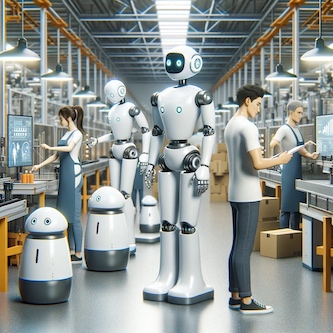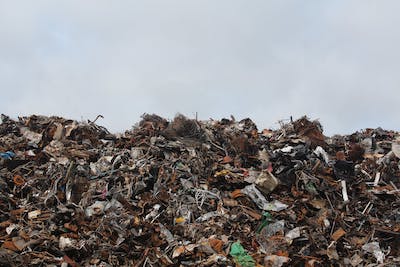Factories around the world are increasingly deploying artificial intelligence (AI) on their production lines to improve efficiency and reduce waste. One example is PepsiCo, which is using AI-powered sensors created by tech firm Augury to detect hardware faults and prevent machine failures. These sensors have been trained on large volumes of audio data to recognize specific patterns of malfunctions. By analyzing machine vibrations and collecting information on equipment health, workers can schedule maintenance in advance and avoid costly downtime. AI-powered sensors also help reduce energy consumption and cut down on waste across operations.
Another application of AI in factories is computer vision, which involves training machines to recognize objects in images and video. This technology is used to detect product defects at scale, particularly in complex products like computer chip wafers and circuit boards. Machines equipped with cameras and algorithms can spot surface-level anomalies that may have gone unnoticed by the human eye. AI is also being used to improve visibility in supply chains, allowing companies to analyze and predict suppliers’ locations and identify bottlenecks. This information not only benefits companies but also provides consumers with insights into the origins and materials used in their products.
The rising adoption of AI tools in factories raises questions about the impact on workers. Some firms are using AI to enhance worker safety by monitoring factory camera feeds for possible threats or accidents. AI-powered wearables like exoskeletons are also being deployed to prevent strain and injuries among workers. However, industry experts believe that AI can bring more value to workers and customers by enhancing efficiency and meeting their needs on a daily basis. For example, AI can help workers perform their tasks more effectively and deliver products to customers more efficiently.
Overall, AI is revolutionizing manufacturing by enabling real-time process monitoring, predictive maintenance, quality control, and supply chain optimization. It is expected to bring even more exciting opportunities in the future, such as capacity sharing between manufacturers and improved visibility in supply chains. While there are concerns about the impact on workers, AI has the potential to enhance worker safety and deliver more value to both workers and customers. As the manufacturing industry continues to embrace AI, it is important to find a balance between automation and human involvement to ensure a successful and sustainable future.
Original news source: How factories are deploying AI on production lines (BBC)
Listen
Slow
Normal
Fast
Group or Classroom Activities
Warm-up Activities:
– News Summary
Instructions: Students will work in pairs to summarize the key points of the article in their own words, aiming to condense the information to just a few sentences. They should focus on the main applications of AI in factories and the potential impact on workers and efficiency.
– Sketch It
Instructions: Divide students into small groups and assign each group a different aspect of the AI applications mentioned in the article (e.g., AI-powered sensors, computer vision, worker safety). Each group must create a visual representation (sketch) of how AI is used in that context, and then present it to the class explaining the benefits and challenges depicted in their drawing.
– Opinion Spectrum
Instructions: Set up a line in the classroom representing a spectrum of opinions, from “strongly agree” to “strongly disagree.” Read out statements about the use of AI in manufacturing, such as “AI will ultimately replace human workers in factories” or “AI-enhanced predictive maintenance will significantly reduce industrial waste.” Students position themselves along the spectrum according to their opinion and discuss their reasoning with the nearest classmates.
– Future Predictions
Instructions: Students will write a short paragraph predicting how AI might further change factory work in the next 20 years. They should consider the implications for efficiency, worker safety, and the global economy. After writing, they will share their predictions with the class and discuss common themes and differing viewpoints.
– Keyword Taboo
Instructions: Prepare cards with keywords from the article (e.g., “artificial intelligence,” “predictive maintenance,” “supply chain,” “worker safety”) and related words that cannot be used in the explanation (e.g., for “artificial intelligence,” taboo words might be “machines,” “smart,” “computer,” “technology”). Students play in teams. One student draws a card and has to describe the keyword to their teammates without using the related words until the teammates guess the keyword correctly.
Comprehension Questions:
1. What is the primary benefit of PepsiCo using AI-powered sensors created by Augury in their production lines?
2. How have the AI-powered sensors been trained to detect hardware faults?
3. In what way do AI-powered sensors contribute to reducing energy consumption and waste?
4. What is the role of computer vision technology in the manufacturing process?
5. How does AI improve visibility in supply chains for companies?
6. What are some of the ways AI is being used to enhance worker safety in factories?
7. What are the anticipated future opportunities for AI in manufacturing according to the article?
8. What is the importance of finding a balance between automation and human involvement in the manufacturing industry?
Go to answers ⇩
Listen and Fill in the Gaps:
Factories around the world are increasingly deploying artificial intelligence (AI) on their production lines to improve efficiency and reduce (1)______. One (2)______ is PepsiCo, which is using AI-powered sensors created by tech firm Augury to detect hardware faults and prevent machine failures. These sensors have been trained on large (3)______ of audio data to recognize specific patterns of malfunctions. By analyzing machine vibrations and collecting information on equipment health, (4)______ can schedule maintenance in advance and avoid costly downtime. AI-powered sensors also help reduce energy consumption and cut down on waste across operations.
Another application of AI in factories is computer vision, which involves training machines to recognize objects in images and video. This technology is used to detect product defects at scale, particularly in complex products like computer chip wafers and (5)______ boards. Machines equipped with (6)______ and algorithms can spot surface-level anomalies that may have gone unnoticed by the (7)______ eye. AI is also being used to improve visibility in supply chains, allowing companies to analyze and (8)______ suppliers’ locations and identify bottlenecks. This information not only benefits companies but also provides consumers with insights into the origins and materials used in their products.
The rising adoption of AI tools in factories (9)______ questions about the impact on workers. Some firms are using AI to enhance worker (10)______ by monitoring factory camera feeds for possible (11)______ or accidents. AI-powered wearables like exoskeletons are also being deployed to prevent strain and injuries among workers. However, (12)______ experts believe that AI can bring more value to workers and customers by enhancing efficiency and meeting their needs on a daily basis. For example, AI can help workers perform their tasks more effectively and deliver products to customers more efficiently.
Overall, AI is revolutionizing manufacturing by enabling real-time process monitoring, predictive maintenance, quality (13)______, and (14)______ chain optimization. It is expected to bring even more exciting opportunities in the (15)______, such as capacity sharing between manufacturers and improved visibility in supply chains. While there are concerns about the impact on workers, AI has the potential to enhance worker safety and deliver more (16)______ to both workers and customers. As the manufacturing industry continues to embrace AI, it is important to find a balance between automation and human involvement to ensure a successful and sustainable future.
Go to answers ⇩
Discussion Questions:
Students can ask a partner these questions, or discuss them as a group.
1. What is your understanding of artificial intelligence (AI) and how do you think it’s changing the landscape of modern industries?
2. How would you feel if your job was assisted or replaced by AI-powered technology?
3. Do you believe AI can enhance worker safety as much as human vigilance can? Why or why not?
4. Can you think of any other industries, besides manufacturing, where AI could significantly improve efficiency?
5. What are some ethical considerations that companies should keep in mind when deploying AI in the workplace?
6. Do you think the use of AI in factories will lead to a significant reduction in employment opportunities? Why or why not?
7. How do you perceive the balance between automation and human involvement in the workforce?
8. Do you like the idea of AI-powered wearables like exoskeletons to prevent strain and injuries? Why or why not?
9. What is your opinion on the potential for AI to create new job opportunities that may not exist today?
10. Have you ever used a product or service that you knew was created with the help of AI? What was your impression of its quality?
11. Do you think AI can truly predict and prevent all types of machine failures in a factory setting?
12. How do you feel about the idea of AI monitoring workers for safety? Do you think it could infringe on personal privacy?
13. Do you believe that AI can provide a level of quality control that surpasses human capabilities?
14. How important do you think it is for consumers to have insights into the origins and materials used in the products they buy?
15. What do you think are the most significant challenges that industries face when integrating AI into their operations?
Individual Activities
Vocabulary Meanings:
Match each word to its meaning.
Words:
1. factories
2. AI-powered
3. sensors
4. efficiency
5. waste
6. defects
7. visibility
8. workers
Meanings:
(a) People who are employed to do a particular job
(b) Places where goods are produced in large quantities
(c) Technology that uses artificial intelligence
(d) Devices that detect and measure physical or chemical properties
(e) Imperfections or faults in a product
(f) The state of being able to see or be seen
(g) Unwanted or unused material or substances
(h) The ability to do something well without wasting time or resources
Go to answers ⇩
Multiple Choice Questions:
1. What is one way that AI is being used in factories?
(a) Designing new products
(b) Increasing energy consumption
(c) Creating waste in operations
(d) Detecting hardware faults and preventing machine failures
2. How does computer vision technology help in factories?
(a) It increases energy consumption
(b) It reduces worker safety
(c) It creates waste in operations
(d) It detects product defects at scale
3. How does AI enhance worker safety in factories?
(a) By increasing strain and injuries among workers
(b) By reducing worker efficiency
(c) By monitoring factory camera feeds for possible threats or accidents
(d) By creating more waste in operations
4. What are some benefits of AI in manufacturing?
(a) Real-time process monitoring, predictive maintenance, quality control, and supply chain optimization
(b) Increasing energy consumption and waste
(c) Decreasing worker safety
(d) None of the above
5. What is one potential future opportunity of AI in manufacturing?
(a) Decreasing visibility in supply chains
(b) Increasing waste in operations
(c) Capacity sharing between manufacturers
(d) None of the above
6. What is the main concern about the adoption of AI in factories?
(a) The impact on workers
(b) The increase in energy consumption
(c) The decrease in efficiency
(d) None of the above
7. How can AI bring more value to workers and customers?
(a) By increasing strain and injuries among workers
(b) By enhancing efficiency and meeting their needs on a daily basis
(c) By creating more waste in operations
(d) None of the above
8. What is important for the future of AI in manufacturing?
(a) Increasing energy consumption
(b) Finding a balance between automation and human involvement
(c) Decreasing worker safety
(d) None of the above
Go to answers ⇩
True or False Questions:
1. AI-powered wearables like exoskeletons are being deployed to prevent strain and injuries among workers.
2. AI is being used to improve visibility in supply chains and predict suppliers’ locations.
3. AI-powered sensors have not been trained on large volumes of audio data to recognize specific patterns of malfunctions.
4. Some firms are using AI to enhance worker safety by monitoring factory camera feeds for possible threats or accidents.
5. AI-powered sensors do not help reduce energy consumption and cut down on waste in factories.
6. AI is not revolutionizing manufacturing by enabling real-time process monitoring, predictive maintenance, quality control, and supply chain optimization.
7. Computer vision technology is not used to detect product defects at scale in complex products like computer chip wafers and circuit boards.
8. PepsiCo is using AI-powered sensors to detect hardware faults and prevent machine failures.
Go to answers ⇩
Write a Summary:
Write a summary of this news article in two sentences.
Check your writing now with the best free AI for English writing!
Writing Questions:
Answer the following questions. Write as much as you can for each answer.
Check your answers with our free English writing assistant!
1. How is PepsiCo utilizing AI-powered sensors in its factories, and what are the benefits of this technology?
2. What role does computer vision play in the quality control process within manufacturing facilities?
3. In what ways can AI contribute to worker safety in factory environments?
4. What are some potential future opportunities for AI in the manufacturing sector mentioned in the article?
5. How does the article suggest balancing automation and human involvement in the manufacturing industry to ensure a sustainable future?
Answers
Comprehension Question Answers:
1. What is the primary benefit of PepsiCo using AI-powered sensors created by Augury in their production lines?
The primary benefit of PepsiCo using AI-powered sensors is to detect hardware faults and prevent machine failures, thereby improving efficiency and reducing waste.
2. How have the AI-powered sensors been trained to detect hardware faults?
The AI-powered sensors have been trained on large volumes of audio data to recognize specific patterns of malfunctions by analyzing machine vibrations.
3. In what way do AI-powered sensors contribute to reducing energy consumption and waste?
AI-powered sensors contribute to reducing energy consumption and waste by allowing workers to schedule maintenance in advance and avoid costly downtime, which in turn optimizes the use of energy and resources.
4. What is the role of computer vision technology in the manufacturing process?
The role of computer vision technology in manufacturing is to train machines to recognize objects in images and video, which is used to detect product defects at scale, especially in complex products like computer chip wafers and circuit boards.
5. How does AI improve visibility in supply chains for companies?
AI improves visibility in supply chains by analyzing and predicting suppliers’ locations and identifying bottlenecks, which helps companies manage their supply chains more effectively.
6. What are some of the ways AI is being used to enhance worker safety in factories?
AI is enhancing worker safety by monitoring factory camera feeds for potential threats or accidents and deploying AI-powered wearables like exoskeletons to prevent strain and injuries among workers.
7. What are the anticipated future opportunities for AI in manufacturing according to the article?
Future opportunities for AI in manufacturing include enabling real-time process monitoring, predictive maintenance, quality control, supply chain optimization, capacity sharing between manufacturers, and improved visibility in supply chains.
8. What is the importance of finding a balance between automation and human involvement in the manufacturing industry?
Finding a balance between automation and human involvement is important to ensure a successful and sustainable future for the manufacturing industry, where AI can enhance worker safety and efficiency without fully displacing human workers.
Go back to questions ⇧
Listen and Fill in the Gaps Answers:
(1) waste
(2) example
(3) volumes
(4) workers
(5) circuit
(6) cameras
(7) human
(8) predict
(9) raises
(10) safety
(11) threats
(12) industry
(13) control
(14) supply
(15) future
(16) value
Go back to questions ⇧
Vocabulary Meanings Answers:
1. factories
Answer: (b) Places where goods are produced in large quantities
2. AI-powered
Answer: (c) Technology that uses artificial intelligence
3. sensors
Answer: (d) Devices that detect and measure physical or chemical properties
4. efficiency
Answer: (h) The ability to do something well without wasting time or resources
5. waste
Answer: (g) Unwanted or unused material or substances
6. defects
Answer: (e) Imperfections or faults in a product
7. visibility
Answer: (f) The state of being able to see or be seen
8. workers
Answer: (a) People who are employed to do a particular job
Go back to questions ⇧
Multiple Choice Answers:
1. What is one way that AI is being used in factories?
Answer: (d) Detecting hardware faults and preventing machine failures
2. How does computer vision technology help in factories?
Answer: (d) It detects product defects at scale
3. How does AI enhance worker safety in factories?
Answer: (c) By monitoring factory camera feeds for possible threats or accidents
4. What are some benefits of AI in manufacturing?
Answer: (a) Real-time process monitoring, predictive maintenance, quality control, and supply chain optimization
5. What is one potential future opportunity of AI in manufacturing?
Answer: (c) Capacity sharing between manufacturers
6. What is the main concern about the adoption of AI in factories?
Answer: (a) The impact on workers
7. How can AI bring more value to workers and customers?
Answer: (b) By enhancing efficiency and meeting their needs on a daily basis
8. What is important for the future of AI in manufacturing?
Answer: (b) Finding a balance between automation and human involvement
Go back to questions ⇧
True or False Answers:
1. AI-powered wearables like exoskeletons are being deployed to prevent strain and injuries among workers. (Answer: True)
2. AI is being used to improve visibility in supply chains and predict suppliers’ locations. (Answer: True)
3. AI-powered sensors have not been trained on large volumes of audio data to recognize specific patterns of malfunctions. (Answer: False)
4. Some firms are using AI to enhance worker safety by monitoring factory camera feeds for possible threats or accidents. (Answer: True)
5. AI-powered sensors do not help reduce energy consumption and cut down on waste in factories. (Answer: False)
6. AI is not revolutionizing manufacturing by enabling real-time process monitoring, predictive maintenance, quality control, and supply chain optimization. (Answer: False)
7. Computer vision technology is not used to detect product defects at scale in complex products like computer chip wafers and circuit boards. (Answer: False)
8. PepsiCo is using AI-powered sensors to detect hardware faults and prevent machine failures. (Answer: True)
Go back to questions ⇧













